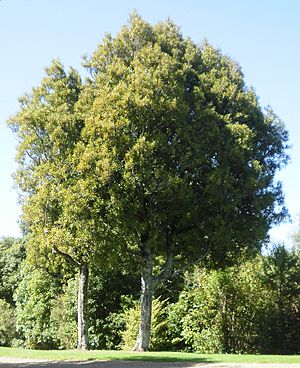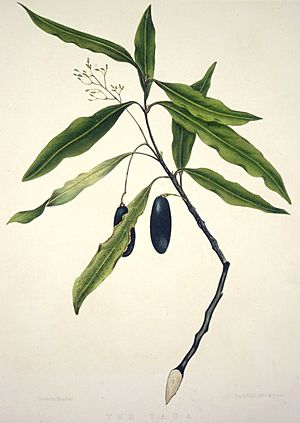Tawa facts for kids
Quick facts for kids Tawa |
|
|---|---|
 |
|
| Scientific classification | |
| Genus: |
Beilschmiedia
|
| Species: |
tawa
|
The Beilschmiedia tawa, often called just tawa, is a tall broadleaf tree found in New Zealand. It is very common in the central parts of the country. Tawa trees often form the main top layer of lowland forests. This is especially true in the North Island and the northeast of the South Island.
Sometimes, tawa trees grow under even taller trees. These taller trees are often podocarps like kahikatea, matai, miro, and rimu. Tawa trees can grow very tall, sometimes over 30 metres high. Their trunks can be as wide as 1.2 metres across. They have smooth, dark bark. The Māori word "tawa" is the name for this tree.
Tawa trees have small flowers that are hard to see. After the flowers, they grow dark red, plum-like fruits. These fruits are quite large, about 2 to 3.5 centimetres long.
How Tawa Spreads Its Seeds
Tawa trees rely on special birds to spread their seeds. The New Zealand pigeon (kererū) is very important for this. The North Island kōkako also helps where it lives. These are the only birds left in New Zealand that are big enough. They can eat the tawa fruits whole. The seeds then pass through their bodies unharmed. This helps new tawa trees grow in different places.
Tawa trees can also be home to many other plants. These plants, called epiphytes, grow on the tawa's branches. They form "gardens" high up in the tree canopy. These canopy gardens are a special place. They are one of the few known homes for the New Zealand striped skink. This skink is a shy lizard that lives in trees.
This tree also gave its name to a place. There is a northern suburb of Wellington called Tawa.
Uses of Tawa Wood and Fruit
The wood from the tawa tree is very useful. It can be made into beautiful and strong floorboards. Most tawa trees are protected in special conservation areas. There are also strong laws to protect them. However, sometimes a license is given to cut down a fallen tree. This allows its timber to be used.
The seed inside the tawa fruit was used by Māori as food. The fruits were cooked in an umu, which is an earth oven. They would steam for two days. After cooking, they were washed to remove the strong-tasting pulp. The dried seeds were then stored for later use. When needed, they were soaked in hot water. Then, they were pounded into a meal. Sometimes, other flavours were added to this mashed meal.
See also
 In Spanish: Tawa for kids
In Spanish: Tawa for kids


